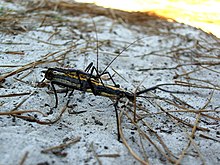
Back شبحيات (حشرات) Arabic شبحيات ARZ Phasmatodea AST Göstərmələr Azerbaijani Палачнікі Byelorussian Пръчици Bulgarian Fasm Breton Fasmatodeus Catalan Phasmida CEB Strašilky Czech
| Stick insect Temporal range: Cretaceous – Recent
| |
|---|---|

| |
| Leptynia hispanica | |
| Scientific classification | |
| Kingdom: | |
| Phylum: | |
| Class: | |
| Superorder: | |
| Order: | Phasmatodea
|
| Suborders | |
| |




Stick insects (also called phasmids, walking sticks, stick-bugs, or ghost insects) are insects in the order Phasmatodea (or Phasmida).
The whole order is camouflaged as either sticks or leaves. Leaf insects are generally the family Phylliidae. They are found in south and southeast Asia to New Zealand.
Over 3,000 species have been described.[2]
The name Phasmatodea comes from the Ancient Greek phasma, meaning an apparition or phantom.